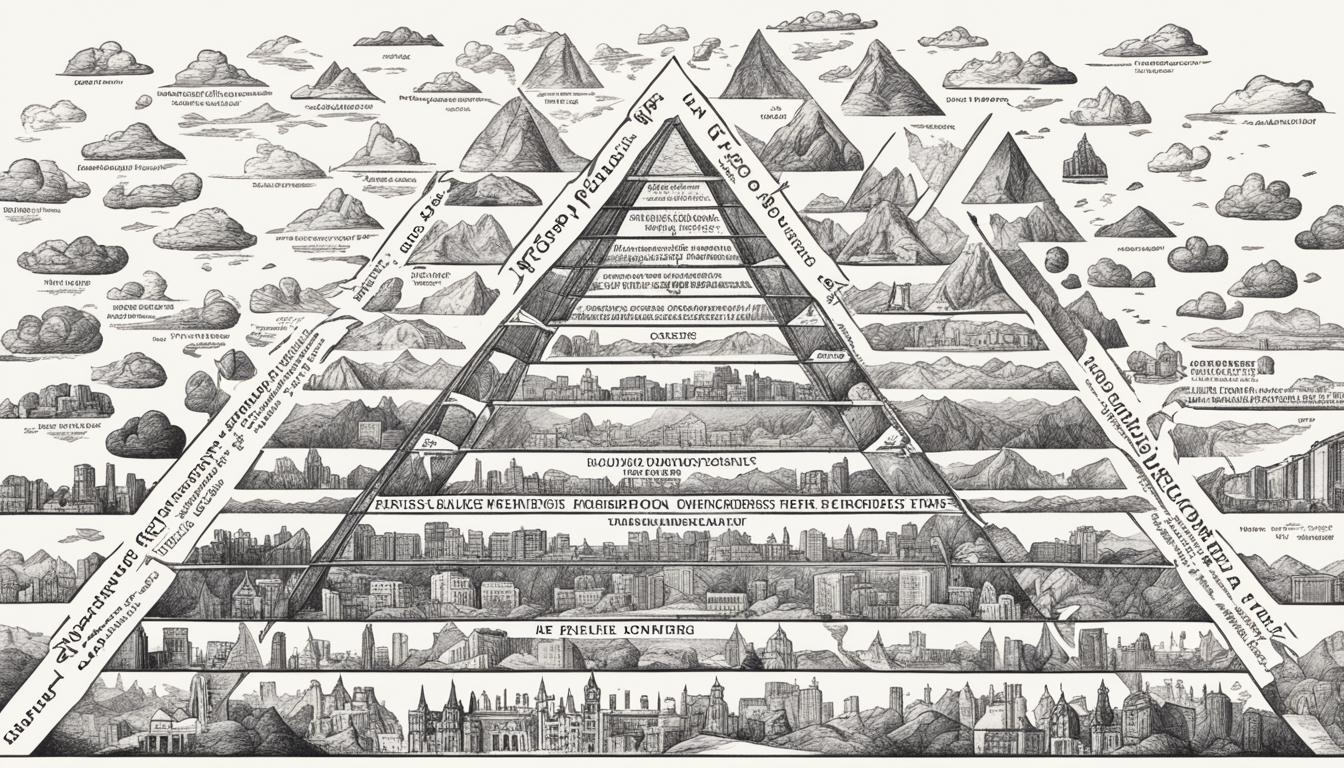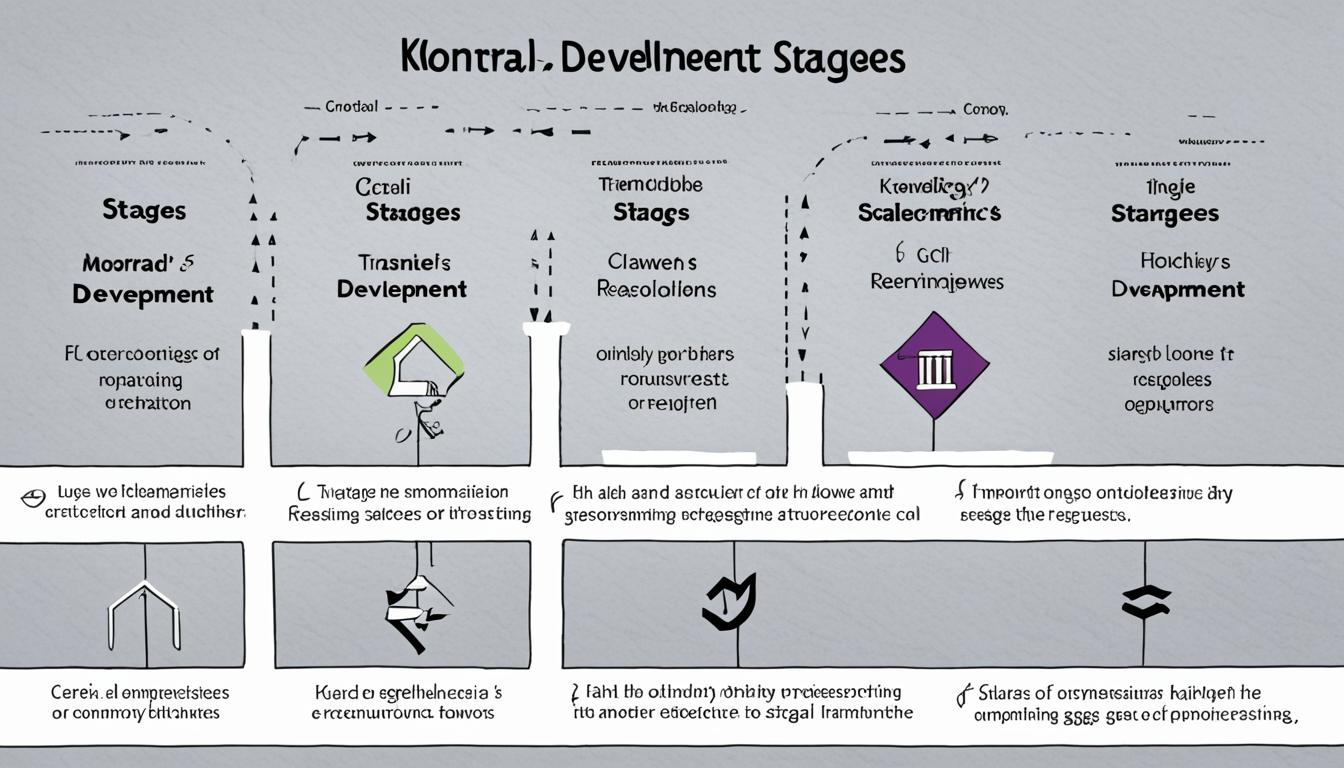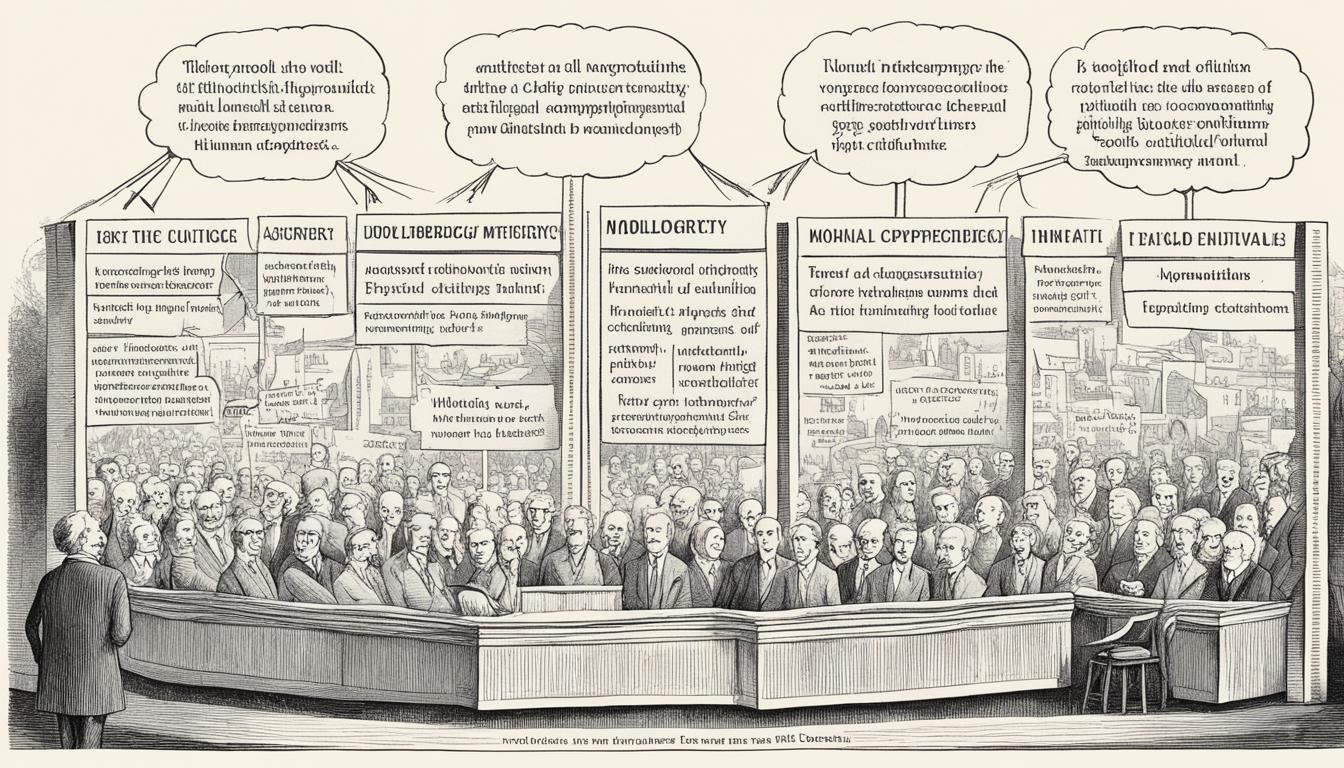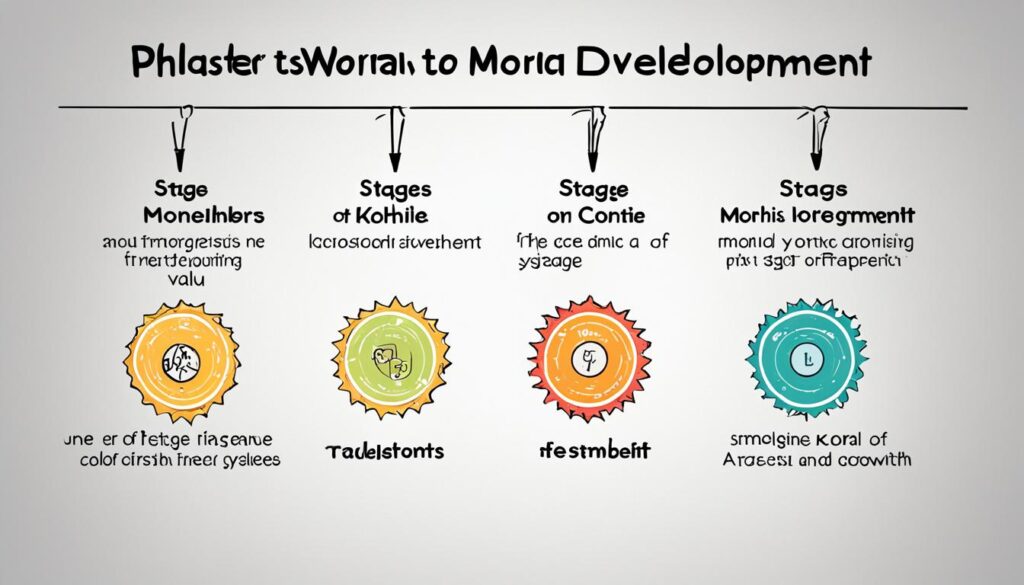Imagine a young child named Sarah who loves to play with her friends at the park every afternoon. One day, while playing hide-and-seek, Sarah accidentally knocks down a bird’s nest, scattering the baby birds across the ground. Sarah’s friends immediately scold her, telling her she should have been more careful. Because of the harm she unintentionally caused, Sarah feels guilty and starts to cry.

This simple scenario reflects an important aspect of moral development – how individuals understand right and wrong. Lawrence Kohlberg, a renowned psychologist, devoted his career to studying how our moral reasoning evolves from childhood through adulthood. This exploration led him to formulate a theory known as Kohlberg’s stages of moral development.
Key Takeaways:
-
Kohlberg’s stages of moral development propose that individuals progress through six distinct stages of moral reasoning.
-
There are three broad categories of moral reasoning – pre-conventional, conventional, and post-conventional – each associated with increasingly complex stages of moral development.
-
Moral understanding is linked to cognitive development, and people move through these stages in a fixed order.
-
Kohlberg used a story called the Heinz dilemma to study moral reasoning and classify individuals into different stages of moral development based on their reasoning.
-
Understanding Kohlberg’s stages of moral development provides insights into how our ethical reasoning evolves over time and can guide parents, educators, and researchers in fostering moral growth and understanding.
Kohlberg’s Levels of Moral Development
In Lawrence Kohlberg’s theory of moral development, he identified three levels of moral reasoning, each representing a different stage of cognitive and moral development.
Pre-conventional Level
In the pre-conventional level, individuals’ moral reasoning is based on external factors and consequences. At this stage, children accept the authority and moral code of others, making decisions based on punishment and reward and direct consequences. Self-interest and a desire to avoid punishment guide their moral judgments.
Conventional Level
The conventional level of moral development is characterized by decision-making based on social rules and expectations. Individuals at this stage value following societal norms and maintaining social order. The expectations and judgments of others, as well as a desire for social acceptance, all influence children develop morality and their moral reasoning.
Post-conventional Level
The post-conventional level represents the highest stage of moral development. Individuals at this level have developed their ethical principles and make decisions based on understanding universal ethical principles. Their moral reasoning extends beyond societal rules and expectations, prioritizing justice, fairness, and individual rights.
Table: Kohlberg’s Levels of Moral Development
| Level | Description |
|---|---|
| Pre-conventional | Externalized morality, guided by punishment and reward |
| Conventional | Socially-oriented morality, following societal rules and norms |
| Post-conventional | Principle-based morality, guided by universal ethical principles |
Level Description Pre-conventional Externalized morality, guided by punishment and reward Conventional Socially-oriented morality, following societal rules and norms Post-conventional Principle-based morality, guided by universal ethical principles
Understanding the various stages of moral development that Kohlberg identified offers useful insights into how people move from having an externally driven sense of morality to developing their own ethical principles. This progression is closely linked to cognitive development and the ability to reason about moral issues.
As individuals grow and mature, their moral reasoning becomes more complex and nuanced. Kohlberg’s theory continues to influence psychology, education, and ethics, guiding researchers, educators, and parents in understanding and fostering moral growth.
Kohlberg’s Heinz Dilemma
Kohlberg employed the Heinz dilemma as a tool to examine moral reasoning. This thought-provoking scenario entails a man named Heinz confronting a life-or-death decision: Should he steal a drug to save his wife’s life? By posing questions, Kohlberg aimed to delve into the moral reasoning behind individuals’ choices. The Heinz dilemma enabled Kohlberg to classify individuals into distinct stages of moral development based on their cognitive reasoning abilities.
Consider the moral complexity of the Heinz dilemma:
Heinz’s wife suffers from a terminal illness, and the only available cure is a prohibitively expensive drug produced by a certain chemist. Heinz implores the chemist to reduce the price or provide it for free, but the chemist refuses, citing the high production costs. Desperate to save his wife’s life, Heinz contemplates stealing the drug. Should Heinz prioritize his wife’s life and steal the drug, or respect the law and let her perish?
The Heinz dilemma catalyzes exploring moral reasoning about Kohlberg’s stages of moral development. It highlights the cognitive processes underlying individuals’ ethical decision-making, shedding light on the intricacies of moral development.

Through analyzing individuals’ responses to the Heinz dilemma, Kohlberg uncovered valuable insights into the various stages of moral development. These stages are essential for understanding how individuals navigate ethical moral dilemmas presented them and make moral judgments. By gaining a deeper understanding of Kohlberg’s Heinz dilemma, we can explore the fascinating world of moral reasoning and its profound impact on our cognitive and moral development.
Preconventional Morality
According to Lawrence Kohlberg’s theory, preconventional morality represents the first level of moral development. At this point, people exhibit externally controlled morality, which means that rather than following their own values or principles, they make moral decisions based on the results of their actions. They adhere to rules to avoid punishment or gain rewards.
In preconventional morality, individuals focus on their self-interest and immediate gratification. They follow rules as long as they serve their needs and desires. For example, a child may refrain from hitting a sibling not because they understand that hurting others is wrong, but because they fear getting punished or losing privileges.
“Preconventional morality represents the initial stage of moral development, where individuals prioritize avoiding punishment or gaining rewards when making decisions.”
During preconventional morality, individuals have limited consideration for the perspectives or needs of others. Rather than internalized ethical principles, external emotional and contextual factors dominate their moral reasoning.
Here is a comparison table that outlines the defining characteristics of preconventional morality:
| Level | Characteristics |
|---|---|
| Preconventional Morality | Moral decisions based on consequencesFocus on avoiding punishment or gaining rewardsSelf-centered perspectiveLittle consideration for others’ perspectives |
| Conventional Morality | Moral decisions based on social rulesDesire for social approval and maintaining social orderConsideration for societal expectationsConcerned with following the rules set by society |
| Postconventional Morality | Moral decisions guided by ethical principlesRecognition of universal ethical valuesAccounting for broader implications of actionsFocus on self-chosen ethical principles |
It is important to note that preconventional morality is a fundamental stage in moral development, but individuals are expected to progress to higher levels as they mature and develop cognitively.
Conventional Morality
Conventional morality represents the second stage of moral development, where individuals prioritize conforming to societal rules and norms. At this level, maintaining social order and the desire for social approval significantly influence moral decisions.
Individuals operating within the realm of conventional morality consider the expectations of others and abide by the established rules set by society. Their moral compass is based on the notion that these societal norms promote harmony and preserve social and good interpersonal relationships.
“When a society functions smoothly, most people adhere to the rules and norms that govern social interactions. It creates an environment where people feel accepted and included.”
For example, consider the societal rule of honesty, which individuals adhering to conventional morality would prioritize. They would value truthfulness to maintain trust and avoid disrupting social relationships. Similarly, they would value loyalty in relationships and respect for authority figures, as these actions contribute to social harmony.
Table 1: Characteristics of Conventional Morality
| Characteristics | Description |
|---|---|
| Social conformity | Individuals conform to societal rules and norms. |
| Desire for social approval | Moral decisions are guided by seeking validation and acceptance from others. |
| Maintenance of social order | Individuals prioritize actions and decisions that contribute to the smooth functioning of society. |
While conventional morality plays a crucial role in promoting societal stability, it is important to acknowledge that it also has limitations. Critics argue that adhering strictly to societal rules may prevent individuals from questioning or challenging immoral practices deeply ingrained in societal norms.
“The conformity to societal rules can stifle individual moral autonomy and hinder moral progress.”
Nonetheless, an individual’s ability to navigate through conventional morality is a stepping stone in their moral development journey, paving the way for exploring higher stages of moral reasoning and developing personal ethical principles.
Postconventional Morality
In moral development, postconventional morality represents the highest level of moral reasoning and understanding. At this stage, individuals demonstrate an advanced comprehension of ethical principles that transcend societal norms and personal interests. Moral decisions are guided by abstract reasoning and self-selected universal principles.
“An individual who has reached postconventional morality is driven by an innate sense of justice and an understanding of the fundamental rights and values that should govern human behavior.”
Abstract Moral Reasoning
Postconventional morality is characterized by the ability to engage in abstract moral reasoning. At this stage, individuals go beyond simple rule-following and consider the broader implications of their actions. They can ethically evaluate complex situations and make decisions based on a comprehensive understanding of the consequences and principles involved.
Self-Chosen Ethical Principles
At the postconventional level, individuals develop a set of self-chosen ethical principles that guide their moral decision-making. These principles result from careful reflection and analysis, not external sources. These principles often revolve around abstract principles of justice, fairness, equality, and human rights.
Universal Principles over Societal Norms
Unlike previous stages of moral development, individuals at the postconventional level prioritize universal principles over societal norms and expectations. They recognize that societal rules can be flawed or unjust and are willing to challenge and question these social norms to pursue higher ethical values. These individuals act by their internal moral compass rather than succumbing to external pressures.
Postconventional morality represents the pinnacle of moral development, where individuals transcend personal interests and societal influences to uphold universal ethical principles. By prioritizing justice, fairness, and equality, those who exhibit postconventional morality serve as proponents of a more enlightened and equitable society.
Critiques of Kohlberg’s Theory
Kohlberg’s theory of moral development has received critiques for its limitations in fully capturing the complexity of moral behavior. Critics argue that moral reasoning, as emphasized in Kohlberg’s theory, does not always translate into actual moral actions. While individuals may demonstrate high levels of moral reasoning, their behavior may not align with their reasoning, highlighting the importance of considering moral behavior alongside moral reasoning.
In addition to critiques regarding moral behavior, Kohlberg’s theory has faced criticism for cultural and gender bias. The research that formed the foundation of Kohlberg’s theory primarily involved male subjects, potentially limiting its generalizability to diverse populations. By drawing conclusions based on a narrow sample, the theory may fail to account for the nuances and variations in how moral development occurs across different cultural and gender contexts.
“Moral reasoning alone cannot fully capture the complexity of moral behavior. Individuals may possess high levels of moral reasoning, but their actions may not align with their reasoning.”
Cultural Bias
One of the main criticisms of Kohlberg’s theory is its cultural bias. The theory was predominantly developed through research conducted in Western societies, overlooking the cultural diversity that influences moral development. Cultural values, norms, and traditions play a significant role in shaping individuals’ moral beliefs and behaviors, and neglecting this cultural context may limit the applicability and accuracy of Kohlberg’s stages of the moral development theory.
Gender Bias
Kohlberg’s theory has also been accused of gender bias. Due to the predominance of male participants in Kohlberg’s research, female perspectives were underrepresented in developing the moral development kohlberg’s theory used. Gender differences in moral development have been observed, with females often demonstrating higher care and concern for others. However, Kohlberg’s theory provides limited insights into these gender-specific differences, potentially oversimplifying the complexities of moral development in girls and women.
| Critiques of Kohlberg’s Theory | Implications |
|---|---|
| Critique 1: Overemphasis on moral reasoning over behavior | Limitation in understanding the gap between moral reasoning and moral actions. |
| Critique 2: Cultural bias | Failure to account for cultural diversity in moral development. |
| Critique 3: Gender bias | Oversimplification of moral development in women due to limited female representation in research. |

Measurement of Moral Development
Based on Kohlberg’s theory, various measurement tools have been developed to assess moral development. These instruments help researchers gain insights into individuals’ moral decision-making processes and evaluate their progression through the stages of moral reasoning. Two commonly used tools for measuring moral development are Kohlberg’s Moral Judgment Interview and the Defining Issues Test.
The Kohlberg’s Moral Judgment Interview is a structured interview that presents respondents with hypothetical moral dilemmas to assess their moral reasoning. It evaluates individuals’ ability to consider different perspectives, weigh moral principles, and make ethical judgments. This interview-based approach provides qualitative data that allows researchers to categorize individuals into specific stages of moral development.
Another useful tool for evaluating moral reasoning is the Defining Issues Test, which James Rest created. This test presents respondents with a series of moral dilemmas and asks them to rank and explain their responses. The test focuses on individuals’ reasoning processes rather than the specific content of their answers. It provides quantitative data that can be used to identify patterns and trends in moral development.
Both the Kohlberg’s Moral Judgment Interview and the Defining Issues Test offer researchers valuable insights into moral development by evaluating individuals’ cognitive processing and decision-making in moral situations. These measurement tools contribute to a deeper understanding of individuals’ moral reasoning and provide a framework for studying moral development across different populations.
The Kohlberg’s Moral Judgment Interview
The Kohlberg’s Moral Judgment Interview is a structured interview that measures the moral judgment development and reasoning through hypothetical moral dilemmas. It assesses individuals’ ability to understand and apply universal ethical principles in their decision-making. The interview consists of a series of moral dilemmas that require respondents to consider different perspectives, weigh conflicting moral principles, and justify their moral decisions. By analyzing respondents’ reasoning processes, researchers can classify individuals into specific stages of moral development.
The Defining Issues Test
James Rest created the Defining Issues Test (DIT), which is a widely used tool for assessing moral reasoning. It assesses individuals’ cognitive moral development by presenting them with a series of moral dilemmas and asking them to rank and explain their responses. The test focuses on the way individuals reason through moral problems and make ethical judgments, rather than the specific content of their answers. The DIT provides quantitative data that allows researchers to analyze moral development trends and patterns within a population.
Comparison of Kohlberg’s Moral Judgment Interview and the Defining Issues Test
Kohlberg’s Moral Judgment Interview Defining Issues Test Structured interview format Self-administered questionnaire format Assesses moral reasoning through hypothetical moral dilemmas Evaluates moral reasoning through a series of moral dilemmas Qualitative data Quantitative data Focuses on classifying individuals into specific stages of moral development Allows analysis of moral development trends and patterns
| Kohlberg’s Moral Judgment Interview | Defining Issues Test |
|---|---|
| Structured interview format | Self-administered questionnaire format |
| Assesses moral reasoning through hypothetical moral dilemmas | Evaluates moral reasoning through a series of moral dilemmas |
| Qualitative data | Quantitative data |
| Focuses on classifying individuals into specific stages of moral development | Allows analysis of moral development trends and patterns |

Basic Tenets of Kohlberg’s Theory
Kohlberg’s theory of moral development is based on several fundamental tenets that shed light on how individuals progress in their moral reasoning and understanding. These key principles provide valuable insights into the stages of moral development and the cognitive processes involved.
Moral Reasoning
At the core of Kohlberg’s theory is the concept of moral reasoning. He posited that individuals engage in moral judgement, a cognitive process to decide right and wrong, based on their understanding of morality. Moral reasoning involves assessing ethical dilemmas, considering various perspectives, and determining appropriate courses of action.
Progressive Stages
According to Kohlberg, moral development is not a static state but a progressive process that unfolds over time. He proposed a sequence of moral stages that individuals advance as they age. Each stage represents a higher moral reasoning and understanding level, building upon the previous one.
Age Trends
Kohlberg argued that older individuals tend to exhibit higher moral reasoning stages than younger individuals. As people mature and gain more life experiences, their moral thinking becomes more complex and nuanced. However, it is essential to note that age trends in moral development can vary across individuals, cultures, and contexts.
Cross-Cultural Validity
Kohlberg’s theory has been studied cross-culturally, and evidence supports its validity in different societies. Although the rate at which individuals progress through the stages may differ, the general pattern of moral development seems to hold across cultures. This suggests that the fundamental principles underlying moral reasoning transcend cultural boundaries.
The Image of Moral Development

Critiques of Kohlberg’s Theory
Critics argue that Kohlberg’s theory may overemphasize justice and overlook other aspects of morality, such as compassion and caring. While justice is a vital component of moral behavior, it is not the sole determinant of ethical decision-making. Moral behavior is multidimensional, encompassing various psychological and emotional factors influencing our choices and actions.
“Moral behavior involves not only the application of justice but also the cultivation of empathy, sympathy, and altruism towards others.”
Furthermore, the theory has faced criticism for its cultural bias. Kohlberg’s research and the development of his theory primarily focused on Western cultures and values, potentially diminishing its applicability in diverse cultural contexts. Different cultures have distinct moral frameworks and values, which must be considered when studying and understanding moral development.
In addition, Kohlberg’s theory has been accused of gender bias. Research conducted to develop and validate the kohlberg’s theory suggests it predominantly involved male subjects, resulting in a limited understanding of moral development in females. Gender differences in moral reasoning and behavior have since been observed, indicating the need for a more inclusive and gender-sensitive approach to studying moral development.
These critiques shed light on Kohlberg’s theory’s potential limitations in capturing moral development’s complexity. While it provides valuable insights into the cognitive aspects of how moral reasoning is, it must be complemented with a broader understanding of moral behavior and factors that influence ethical decision-making.

| Critique | Description |
|---|---|
| Overemphasis on Justice | Kohlberg’s theory may prioritize justice at the expense of other moral dimensions, such as compassion and caring. |
| Cultural Bias | The theory’s Western-centric focus limits its applicability to diverse cultural contexts, potentially overlooking culturally specific moral frameworks. |
| Gender Bias | Research predominantly conducted with male subjects fails to capture the full range of moral development in females. |
Conclusion
Understanding Kohlberg’s stages of moral development provides valuable insights into the evolution of ethical reasoning over time. Kohlberg proposed a theory that individuals progress through distinct stages of moral reasoning, categorized into pre-conventional, conventional, and post-conventional levels of moral development. This progression is intricately linked to cognitive development, as individuals move from following external rules post conventional morality to developing personal ethical principles.
Despite facing criticisms, Kohlberg’s theory remains a significant contribution to the field of moral psychology. It guides parents, educators, and researchers foster moral growth and understanding. The theory’s emphasis on the importance of cognitive development in shaping moral reasoning provides a framework for promoting ethical decision-making and behavior.
While Kohlberg’s theory has been criticized for its potential cultural and gender biases, its overall impact on the study of moral development cannot be overlooked. By recognizing the stages of moral reasoning, individuals and society can better comprehend the complex process of ethical growth. This understanding enables us to nurture moral development and promote a more conscientious and compassionate world.
FAQ
What are Kohlberg’s stages of moral development?
Kohlberg proposed six stages of moral development: three stages each at the pre-conventional, conventional, and post-conventional levels.
How does moral reasoning develop according to Kohlberg’s theory?
According to Kohlberg, moral reasoning develops in a fixed sequence from infancy to adulthood, with individuals progressing through the stages in the pre-conventional, conventional, and post-conventional levels.
How does the Heinz dilemma relate to Kohlberg’s theory of moral development?
Kohlberg used the Heinz dilemma, a story about a man faced with a moral decision, to study individuals’ moral reasoning and classify them into different stages of moral development.
What is preconventional morality?
Preconventional morality is the first level of moral development, where individuals make moral decisions based on avoiding punishment and seeking rewards rather than personal, moral values, or principles.
What is conventional morality?
Conventional morality is the second level of moral development, where individuals conform to societal rules and norms to gain social approval and maintain social order.
What is postconventional morality?
Postconventional morality is the highest level of moral development, where individuals make moral decisions based on abstract ethical principles and their own self-chosen ethical principles, prioritizing universal principles over any societal laws, norms or personal gain.
What are some critiques of Kohlberg’s theory?
Kohlberg’s theory has been criticized for overemphasizing moral reasoning without considering actual moral behavior, cultural bias, and gender bias.
What measurement tools are used to assess moral development based on Kohlberg’s theory?
The Kohlberg’s Moral Judgment Interview and the Defining Issues Test are two commonly used measurement tools to assess moral reasoning based on Kohlberg’s theory.
What are the basic tenets of Kohlberg’s theory?
The basic tenets of Kohlberg’s theory are that older individuals tend to exhibit higher stages of moral reasoning, moral development is cumulative and progresses in a specific sequence, and age trends in moral development are supported cross-culturally.
What are some critiques of Kohlberg’s theory?
Some critiques of Kohlberg’s theory include its overemphasis on justice, cultural bias, and gender bias.
What can we learn from Kohlberg’s stages of moral development?
Understanding Kohlberg’s stages of moral development provides insights into how our ethical reasoning evolves over time, guiding parents, educators, and researchers in fostering moral growth and understanding.

